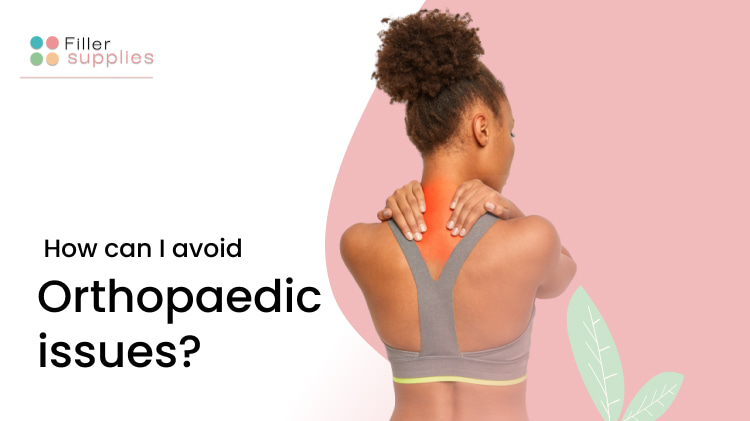How Can I Avoid Orthopaedic Issues?

Orthopaedic problems are some of the most common health concerns of older people. However, unfortunately, these inconveniences can develop at a young age as well, although this situation is rather rare.
The good news is that orthopedic conditions don’t occur overnight, and there are many ways to prevent them or at least to catch them early. More so, there are many treatments that can improve your orthopedic health as well! But let’s not get ahead of ourselves and start from the beginning.
What Orthopedic Issues Do People Suffer From?
Unfortunately, there are numerous orthopedic issues people all around the world suffer from. Some have internal, others – external causes. However, if there is something they have in common, is the fact that all of them can be prevented or managed with some help from a qualified healthcare provider.
Some of the most frequent orthopaedic problems both young and old people can suffer from are:
- Joint pain (such as elbows and knee pain);
- Neck pain;
- Back pain;
- Arthritis;
- Osteoarthritis;
- Fractures (due to the loss of the bone mass);
- Osteoporosis, and others.
It’s important to note that, if you suspect having any orthopedic problems, you should not self-diagnose. If you experience alarming symptoms, such as pain, joint swelling, high temperature, and others, the best thing to do is to seek medical advice.
What Causes Orthopedic Problems?
There is a wide range of orthopaedic conditions, and their causes vary as well. Some of the diseases are the results of both acute and chronic traumas, some are age-related. Sometimes, the body’s immune system attacks healthy cells, causing inflammation and, consequently, rheumatoid arthritis.
To spare the details, there is a list of the most common causes of orthopedic health problems. The more precise information can be obtained from your medical provider:
- Orthopedic injuries;
- Autoimmune disorder;
- Unhealthy body weight;
- Health conditions that weaken muscles;
- “Wear and tear”;
- Decreased bone density;
- Predisposition to orthopedic diseases.
Fortunately, there are many methods and treatments to address and prevent long-term musculoskeletal system damage. They are about to be briefly reviewed in the next parts of this article.
Is Physical Therapy an Effective Way to Treat Orthopedic Issues?
When the condition is not crucial, a doctor is likely to recommend physical therapy to improve minor health issues. Such therapy includes sets of exercises targeted either at all muscle groups or at specific body parts such as legs, back, and others.
Basically, physical therapy is a collection of exercises that can be done with reduced risk of traumatizing. It’s an effective way to improve posture, strength, and agility for all people, even those in perfect health.
Still, to prevent injuries, it’s important not to rush the process but to do the exercises without haste. Take some time to learn what you can do easily and what you can’t do yet. Remember that the main goal of the therapy is to maintain your health, not making you break Guinness records.
Can Filler Injectables Improve Orthopedic Health?
Another effective treatment for people suffering from joint pain and swelling is filler injectables. Of course, they are not the ultimate medicine that will eradicate the disease for good. However, the solution can win you up to 6 months free from elbow and knee pain.
The most popular brands of orthopedic filler treatments are:
The mode of operation is fairly simple. The injectable imitates synovia, also referred to as “synovial fluid”, thus ensuring the swift movement of the joint and reducing friction. It is possible due to the lack of natural synovia in people with osteoarthritis and other related conditions.
The injectables are also claimed to cause an anti-inflammatory effect, which plays a role in reducing painful sensations as well.
Even though it is easy to find Monovisc, Supartz, Synvisc, and other orthopedic fillers online, they must be administered by educated healthcare professionals only. Patients risk making more harm than good and cause serious injury and other complications by trying to inject a medicine on their own.
At Fillersupplies.com, we provide you with a comprehensive guide on what to expect before and after Botox treatment. Our before and after Botox treatment guide Before and After Botox Treatment Expectations, potential side effects, and what to expect during the recovery process. Trust us to provide you with the information you need to make informed decisions about your cosmetic needs.
Additional Preventive Measures
Sometimes, medications are not enough to fully address the existing health problem. This is when it’s time to turn to alternatives.
Sticking to simple recommendations will not only improve your overall health but will also keep a variety of orthopedic complications from further development.
Opting for Supportive Shoes
There is an abundance of pretty and fashionable but poorly made shoes. While staying trendy is an understandable desire, it is strategically better to opt for comfortable shoes that promote and maintain proper alignment.
Besides, there is plenty of reputable brands that allow staying both healthy and fashionable.
Regular Exercise and Physical Activity
“Moving is living” is a motto that you must adopt. Developing strong core muscles and staying fit is a must for all people, not only those suffering from or predisposed to certain orthopaedic issues.
Working on increasing your muscle mass will eventually pay off. With the help of well-developed muscles, the bones won’t need to be under enormous pressure almost 24/7.
Stretching
Stretching is as vital as regular exercises. Still, before doing the splits during your first workout, spend as much time as needed learning about proper techniques.
A mindful and responsible approach to stretching will allow you to achieve maximum results without getting painful joint injuries and unbearable muscle soreness.
Sticking to Healthy Habits
Eating habits are something that people suffering from arthritis and other related conditions often overlook. Nevertheless, getting enough vitamins and minerals is a crucial part of staying within the range of healthy weight, which will ensure healthy bones as well.
Pay special attention to magnesium supplements, fish oil, and food rich in collagen, as these components are vital for maintaining the well-being of your bones and joints.
Annual Checkups
A lot of people choose to ignore the importance of regular checkups. However, they are a necessary part of keeping track of your physical condition.
Even if you don’t feel any suspicious symptoms, a doctor might be able to detect insignificant issues that, when left to their own devices, might develop into undesirable conditions.
However, there is no need to panic or become hypochondriac. Just don’t forget to pay your medical provider a visit once a year or two.
In Conclusion
Orthopedic health can be somewhat tricky to maintain. It’s important to find a qualified medical professional who is educated to provide comprehensive orthopaedic care, thus allowing a patient to live a full life.
While associated diseases are more frequent in people over 45 years old, young people can be predisposed to orthopedic problems as well, which makes it necessary to be attentive to your health.
When the first symptoms occur, a decent orthopaedic specialist will advise on effective therapy and medications if necessary, as well as will provide general advice about a healthy lifestyle that will keep potential problems at bay.










